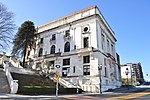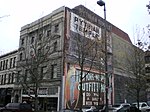Working Waterfront Maritime Museum
Historic American Engineering Record in Washington (state)Industry museums in Washington (state)Maritime museums in Washington (state)Museums in Tacoma, Washington
The Working Waterfront Maritime Museum is a Maritime Museum located in Tacoma, Washington, USA. The museum sits on the Thea Foss Waterway. Along with the Discovery Wharf Children's Activity Area, the WWMM is a part of the Foss Waterway Seaport, a 501c3 non-profit organization founded in 1996. In conjunction with the Foss Waterway Development Agency, the Seaport seeks private and public funds to support its mission statement. The Working Waterfront Maritime Museum is dedicated to creating "a permanent education and activity venue on the Tacoma waterfront".
Excerpt from the Wikipedia article Working Waterfront Maritime Museum (License: CC BY-SA 3.0, Authors).Working Waterfront Maritime Museum
Dock Street, Tacoma
Geographical coordinates (GPS) Address Website External links Nearby Places Show on map
Geographical coordinates (GPS)
| Latitude | Longitude |
|---|---|
| N 47.257847 ° | E -122.437366 ° |
Address
Working Waterfront Maritime Museum
Dock Street
98402 Tacoma
Washington, United States
Open on Google Maps









